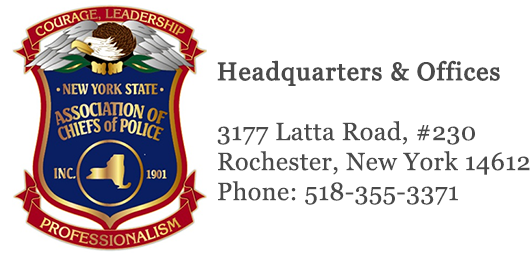- Home
- About
- Members
- Publications
- Chief's Chronicle
- Legislative Center
- Press Releases
- Sheriffs/Chiefs Budget Letter
- Press Release - Memorandum of Opposition
- Open Letter to the Governor June 11th 2020
- New York State Association of Chiefs of Police Statement - the Resignation of Rochester Police Chief La'Ron Singletary
- NYSACOP Letter Addressing Thanksgiving Day Gatherings Enforcement
- A Letter from NYSACOP - Commentary on Law Enforcement Involvement on Gathering Limits during Thanksgiving
- Statement on Ithaca Police Reform Panel Member Richard Rivera
- Mid-Hudson Chiefs of Police Association Press Release on Marijuana Legalization Meeting
- NYSACOP Response to Anti-Defamation League Statement
- Content and Advertising Deadlines for NYSACOP Publications
- Traffic
- Traffic Safety Committee Minutes
- Notable Traffic Safety News
- Training Opportunities
- Drug Recognition Expert (DRE) Training
- DWI Detection and Standardized Field Sobriety Testing Refresher Course
- DWI Detection and Standardized Field Sobriety Testing - Instructor Refresher Course
- Recognizing the Cannabis Impaired Motorist
- Breath Analysis Operator Course
- Breath Analysis Instructor Course
- DWI Detection and Standardized Field Sobriety Testing Instructor Course
- Crash Management Course Training Series Spring 2026
- Crash Management Course Training Series Fall 2025
- Commercial Vehicle Enforcement Training
- Documents and Information
- Traffic Safety Committee Members
- Resource Center
- Partnership Program
|
Joseph A. Sinagra - President As a law enforcement officer, a member of the Board of Governors of the New York State Association of Chiefs of Police and the president of the Mid-Hudson Police Chiefs Association, I am disappointed in the lack of commonsense by our elected officials who recently voted and supported the legalization of marihuana in New York State. The legalization of Marihuana was bound to happen. However, our state legislature once again failed to listen to the concerns of law enforcement. This marihuana law lacks in enforcement of those who choose to drive under the influence of marihuana. This legislation also fails to adequately address possession of marihuana by persons under the age of 21.
Those operating under the influence of Marihuana, THC-impaired drivers in New York State will suffer no legal consequences when they have caused a crash or death. The legislature has yet to address the impaired or the under the influence of marihuana driver. Both the assembly and senate have failed to deal with marihuana impairment/intoxication. The alcohol impaired/intoxicated driver was addressed in the past through the establishment of a legally accepted quantitative threshold, establishing scientific defined blood alcohol concentrations for both impairment and intoxication. Currently there is no legally defined quantitative threshold for determining the amount of marihuana THC (measured in ng/ml) for the purpose of identifying the marihuana impaired or intoxicated driver. This same law also states that persons 21 years of age and older may possess up to three ounces of marihuana for personal use. Possession of more than three ounces is illegal. However, the law does not address enforcement or penalty for the possession of marihuana by those less than 21-years of age, unless they possess more than three ounces. Once again, in their haste to pass legislation, both the assembly and senate failed to recognize this major flaw in their plight to be amongst the minority of states that have irresponsibly legalized marihuana. Or, did our state legislature intend to make it lawful for our children to possess marihuana? We are in the midst of an opioid epidemic, in the middle of a pandemic, and the legislative priority was to dump another addicting drug onto society, further endangering those on our roadways and in our communities. This legislation is by far from becoming a national model ! Joseph A. Sinagra |

 Mid-Hudson Association of Chiefs of Police
Mid-Hudson Association of Chiefs of Police































